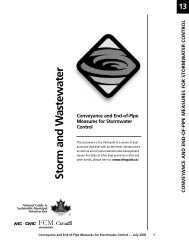The State of Canada's Cities and Communities 2012 - FCM
The State of Canada's Cities and Communities 2012 - FCM
The State of Canada's Cities and Communities 2012 - FCM
You also want an ePaper? Increase the reach of your titles
YUMPU automatically turns print PDFs into web optimized ePapers that Google loves.
Chapter 5<br />
Page 6<br />
CONDOMINIUMS AS CONTRIBUTING TO THE RENTAL MARKET<br />
Condominiums represented 29% <strong>of</strong> all new housing starts in Canada in 2010 <strong>and</strong> 36%<br />
in QOLRS communities. While the primary purpose <strong>of</strong> condominium construction is for<br />
homeownership, there is an upward trend in buyers investing in one or more condominiums<br />
<strong>and</strong> then renting them out, resulting in a supply <strong>of</strong> rental units. CMHC’s October 2011<br />
Rental Market Survey <strong>of</strong> 11 city centres showed an overall increase in condominium rentals<br />
with an average vacancy rate <strong>of</strong> 2%, well below the balanced vacancy rate <strong>of</strong> 3%.<br />
In some markets, condominiums play a significant role in rental housing. A 2008 CMHC<br />
survey <strong>of</strong> the Vancouver rental market showed that 27% <strong>of</strong> Vancouver’s condominium<br />
stock, <strong>and</strong> 8% <strong>of</strong> Ottawa’s, was rented. In 2005 condominium rentals in Toronto represented<br />
20% <strong>of</strong> the total rental supply. 12 Despite this pocket <strong>of</strong> rental condominium housing,<br />
vacancy rates remain low in these cities.<br />
Condominium development also contributes to the erosion <strong>of</strong> affordable rental. <strong>Cities</strong> are<br />
seeing an overall decline in rental units where the trend is to convert apartment buildings<br />
to condominiums, instead <strong>of</strong> building new condominiums. Condominium rental prices are<br />
consistently higher than apartment rents in cities in CMHC rental market survey including<br />
Toronto, Ottawa, Calgary <strong>and</strong> Vancouver.<br />
Regina’s recent condo boom has not come at the expense <strong>of</strong> its rental housing stock,<br />
thanks to the innovative <strong>and</strong> progressive municipal incentives for new rental housing. In<br />
2009, the City adopted a new housing policy aimed at encouraging the construction <strong>of</strong><br />
new housing in inner-city areas <strong>and</strong> stimulating new rental housing development city-wide.<br />
Investment in new rental housing is typically<br />
lower in QOLRS communities than the rest <strong>of</strong><br />
Canada, with relatively fewer starts intended for<br />
the rental market. Two notable exceptions were<br />
the rental markets <strong>of</strong> Saskatoon <strong>and</strong> Regina.<br />
Both communities experienced dramatic increases<br />
in rental starts in 2010 as a result <strong>of</strong> local<br />
government initiatives for new rental housing<br />
incentives. From 2007 to 2009, 2.7% <strong>of</strong> new<br />
units built in Saskatoon <strong>and</strong> 5.5% in Regina were<br />
intended for the rental market. In 2010 this increased<br />
to 12.2% <strong>and</strong> 19.1% respectively.<br />
With its booming economy, Saskatoon’s<br />
vacancy rate hit critically low levels <strong>of</strong> less than<br />
1% by 2007. Market forces were not responding<br />
adequately: in 2009, less than one in 500 new<br />
housing starts was purpose-built rental. In 2010,<br />
the City <strong>of</strong> Saskatoon stepped in with two<br />
municipal initiatives. A $5,000 per unit incentive<br />
grant <strong>and</strong> a five-year incremental tax rebate<br />
for purpose-built rental housing saw new rental<br />
housing starts rise to 12.2%. Under the fund,<br />
new units must remain rentals for 15 years <strong>and</strong><br />
conversions are not permitted.<br />
Stagnant Rental Market Investment<br />
Rents across Canada continue to increase<br />
annually with monthly rents consistently higher<br />
in the QOLRS communities than the rest <strong>of</strong><br />
Canada. By 2010, the median monthly rent for<br />
a two-bedroom apartment in QOLRS communities<br />
rose to $850 from $661 in 2001, compared<br />
to the Canadian average rent <strong>of</strong> $775, which rose<br />
by $169 over the same period. 13<br />
In 2010, median rent in Vancouver was significantly<br />
higher than other communities; the<br />
$1,400 price for a two bedroom was $325 higher<br />
than in Halton Region, the community with the<br />
second highest rents nationally. <strong>The</strong>se are followed<br />
closely by Peel at $1,060 <strong>and</strong> Toronto,<br />
11 City <strong>of</strong> Toronto, ‘Rental Housing Supply <strong>and</strong> Dem<strong>and</strong> Indicators,’ September 2006, p. 7. Available at http://www.toronto.ca/planning/pdf/<br />
housing_rental.pdf.<br />
12 Figures presented are in non-adjusted dollars.

















